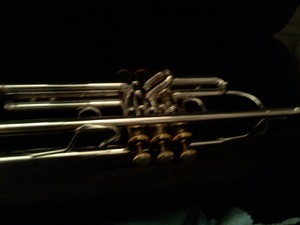Trumpet Care and Maintenance: Tips to Keep Your Horn in Top Playing Condition
I have been involved in playing and teaching music for more than twenty years. I am primarily a trombonist, but along the way have learned to play trumpet, French horn, tuba, and euphonium fairly proficiently. Teaching private lessons on different instruments for the last fourteen years has shown me that many players, particularly young players, have little idea how to care for their instruments to keep them in top playing condition. Here are some tips that will help young trumpet players learn how to keep their instruments in great shape.
What you will need: Any quality music store that carries band instruments should have all the materials you will need to keep your trumpet clean and working well. You will need valve oil, tuning slide grease, a soft cloth (a cloth baby diaper works well), and a small cleaning snake. Make sure that the brush end of the cleaning snake is small enough to go easily through the various metal tubes of your trumpet.
Oiling the valves: Oiling your trumpet’s valves is the most frequent and probably the most important regular maintenance you will have to perform. The valves are very delicate, so you must be careful not to dent or bend any part of them while you work. Start by unscrewing the top cap of your first valve and carefully removing it from the valve casing. Wipe the valve and the interior of the valve casing with your soft cleaning cloth, making sure there is no lint left behind. Hold the valve at an angle and drip valve oil on it, turning it so that the oil coats all sides of the cylinder.
A small amount should suffice, but you do want to make sure that the valve is coated fairly well. To reinsert the valve, look into the casing. There will be a notch somewhere on the interior of the cylinder. Line up the valve with the notch and reinsert it straight into the casing.
Screw the valve cap on tightly and test the valve to make sure it moves easily. Repeat the process with the other two valves. If you remove all three valves at once, be sure that you do not get them mixed up! The valves will only work in the slot they came out of; they are not interchangeable. Most brass instrument valves are numbered on the sides, so this helps keep from getting them mixed up.
Tuning slides: It is very important to keep your tuning slides clean and well-lubricated, particularly the third valve slide. Begin by removing the tuning slide and wiping it with your soft cloth. Run your cleaning snake through both the slide itself and the trumpet casing where it will be reinserted, wiping off any gunk that comes out on the brush. Rub a small amount of tuning slide grease (or oil) all over the part that will be reinserted in the trumpet.
It doesn’t take very much! Reinsert the tuning slide and pump it a few times to coat evenly and to make sure it moves well. It is important to remember that if you are moving valve tuning slides, you should press down the corresponding valve until you have finished moving its slide. Moving or removing the tuning slide without holding in its valve can cause back pressure and can damage your trumpet.
General cleaning: The main part of your horn can be cleaned with a solution of mild soap and water. Remove the tuning slides and valves and slowly pour the soapy solution through the interior, swishing to make sure it hits all parts of the horn.
Rinse thoroughly with clear water, re-grease your tuning slides and re-oil your valves before reinserting them. The exterior of your horn can be kept shiny and free of fingerprints and other marks and smudges just by wiping and polishing as needed with your soft cloth. Brasso and other metal-polishing substances can sometimes damage the finish of brass instruments, so use them very sparingly if at all.



